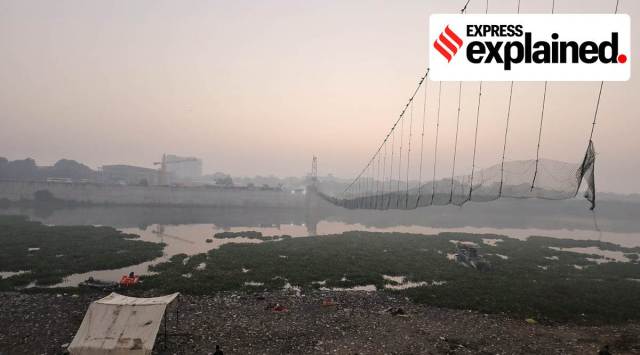- India
- International
How suspension bridges work, and what could have happened in Gujarat’s Morbi
The bridge that collapsed in Morbi, Gujarat, was built using an old, robust technology. But overloading and excessive swaying present risks to such structures
 In Morbi, the vertical cables seem to have snapped entirely from the deck at one end of the bridge, sending part of the unsuspended deck and those on it plunging into the river. (Express Photo by Nirmal Harindran)
In Morbi, the vertical cables seem to have snapped entirely from the deck at one end of the bridge, sending part of the unsuspended deck and those on it plunging into the river. (Express Photo by Nirmal Harindran)The bridge that collapsed in Gujarat’s Morbi on Sunday killing at least 134 people, was a suspension bridge — a type in which the deck is hung below suspension cables on vertical suspenders.
The basic structural components of a suspension bridge system include stiffening girders, two or more main suspension cables, and towers and anchorages for cables at either end of the bridge. The main cables are suspended between the towers and are connected to the anchorage or the bridge itself. The vertical suspenders carry the weight of the deck and the commuter load on it.
The design ensures that the load on the suspension cables is transferred to the towers at the two ends, which transfer them further by vertical compression to the ground by way of the anchorage cables.
 Suspension bridges depend on the balance of the forces of compression and tension
Suspension bridges depend on the balance of the forces of compression and tension
All of this balancing has to happen within the permissible weight restrictions for the bridge, given that the deck is hanging in air, supported by the two sets of cables. Given that the most important load bearing members are the main suspension cables, the entire cross-section of the main cable is the mainstay of carrying the load and ensuring that buckling does not happen.
But this is subject to two preconditions: there must be no overloading, and no excessive swaying.

Morbi bridge collapse: What could have happened
Even as an investigation into the accident is pending, the visuals and purported footage prior to the incident seem to suggest that both these preconditions were possibility tested.
The 19th century bridge, which had been reopened days previously after repairs spanning six months, reportedly had over 400 people on it when it collapsed. And while the weight limit is not known, purported video footage from before the incident seems to suggest the bridge was swaying, possibly because of the large crowd on it.
Sudib Kumar Mishra, associate professor at the Department of Civil Engineering at IIT-Kanpur who specialises in structural engineering, said the way the bridge snapped was somewhat unusual.
“Full information is not available, but based on the videos that are circulating, I was a bit surprised at the manner in which the entire bridge collapsed in a single instant. What is usually expected in incidents like these is that one or two suspension cables give way, and the bridge breaks and hangs before the rest of the structure collapses. It is a slower process.
“But the sudden collapse, as seen in the videos, suggest that most or all the suspension cables were weak or corroded. This is possible considering that this was a very old bridge. But we are also being told that it was recently repaired. We will have to wait for details on what kind of repairs or maintenance was carried out,” Dr Mishra said.
A second factor, Dr Mishra said, is the load from the pedestrians. “We are being told that there was overcrowding, though we do not know to what extent the capacity was exceeded. Unlike aerodynamic instability caused by strong winds, which is now very well understood and is almost entirely eliminated from modern suspension bridges, the impact of the behaviour of pedestrians is not very well understood or modelled. What is, however, known is that the impacts are non-linear,” he said. Thus, “a very excited crowd, or someone jumping can have a disproportionate impact”. However, Dr Mishra said, a proper assessment can be made only after a thorough on-site review.
Visuals from the site appear to suggest that the two towers were unaffected. The twin suspension cables arising from the towers, which ran along the length of the bridge and were connected to the vertical cables holding up the road deck, also seem to be in place. What seems to have given way are the connections securing the vertical cables with the deck, especially on one end of the bridge.
Role of vertical support
The job of the vertical cables in a suspension bridge is to transfer the weight of the deck, by tension, to the twin suspension cables that run horizontally between the two anchorages on either end, which, in turn, transfer the tension to the towers and, through them, to the ground by way of cables whose ends are anchored.
In Morbi, the vertical cables seem to have snapped entirely from the deck at one end of the bridge, sending part of the unsuspended deck and those on it plunging into the river.
What could be of particular interest to investigators is the fact that during the recent repairs, the original wooden deck had possibly been replaced with an aluminum deck, which could have involved rewiring the mechanism connecting the vertical cables with the deck, thereby likely altering the basic structure of the bridge that had endured for well over a century.
The bridge is owned by Morbi municipality, which had signed a contract with a trust owned by private company Oreva — which makes digital products ranging from Ajanta clocks to battery operated bikes — for maintenance and operations. Emails sent to Oreva and district administration on the specific issue of changes made to the bridge structure during the repair works went unanswered.
Robustness of these bridges
The core design of a bridge determines how it distributes the internal forces of tension, compression, torsion, bending, and sheer. Suspension bridges are among the most robust structures, starting from the earliest ones made of twisted grass. When Spanish conquistadors made their way into Peru in 1532, they discovered an Incan empire connected by hundreds of suspension bridges spanning deep mountain gorges.
The Golden Gate Bridge and Brooklyn Bridge in the US are examples of suspension bridges. India’s longest single-lane motorable suspension bridge — the 725-metre Dobra-Chanti suspension bridge built over the Tehri lake — was inaugurated in November 2020.
Besides suspension, bridges can be arch bridges, beam bridges, cantilever bridges, truss bridges and tied-arch bridges. While beam bridges are among the simplest and oldest bridges, the reason for the enduring design of the suspension bridge is that the supporting cables running horizontally between the two far-flung anchorages provide the counterweight and effectively pass on the entire tensional force to the anchorages.
As a result, suspension bridges can easily cross distances of well over 2,000 metres, beyond the scope of other bridge designs. The Morbi bridge was on the smaller side in terms of span, and was pedestrian-only.
More Explained
EXPRESS OPINION
Apr 25: Latest News
- 01
- 02
- 03
- 04
- 05










































